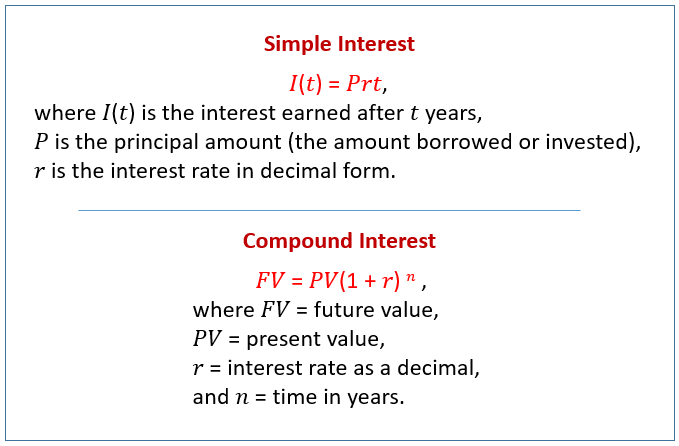Simple and Compound Interest
Related Topics:
Lesson Plans and Worksheets for Algebra I
Lesson Plans and Worksheets for all Grades
More Lessons for Algebra I
Common Core For Algebra I
Examples, solutions, and videos to help Algebra I students compare the rate of change for simple and compound interest and recognize situations in which a quantity grows by a constant percent rate per unit interval.
New York State Common Core Math Algebra I, Module 3, Lesson 4
Lesson Summary
The following diagram shows the simple interest formula and compound interest formula. Scroll down the page for more examples and solutions.

Simple Interest: Interest is calculated once per year on the original amount borrowed or invested. The interest does not become part of the amount borrowed or owed (the principal).
Compound Interest: Interest is calculated once per period on the current amount borrowed or invested. Each period, the interest becomes a part of the principal. Unlike simple interest, compound interest grows exponentially over time because interest is earned on both the principal and the accumulated interest.
Simple interest is like earning a flat fee, while compound interest is like a snowball effect.
Compound interest is generally more beneficial for investments, while simple interest is generally less costly for loans.
Exit Ticket
A youth group has a yard sale to raise money for a charity. The group earns $800 but decides to put its money in the bank for a while. Calculate the amount of money the group will have if:
a. Cool Bank pays simple interest at a rate of 4%, and the youth group leaves the money in for 3 years.
b. Hot Bank pays an interest rate of 3% compounded annually, and the youth group leaves the money in for 5 years.
c. If the youth group needs the money quickly, which is the better choice? Why?
Problem Set Sample Solutions
- $250 is invested at a bank that pays 7% simple interest. Calculate the amount of money in the account after 1 year, 3 years, 7 years, and 20 years.
- $325 is borrowed from a bank that charges 4% interest compounded annually. How much is owed after 1 year, 3 years, 7 years, and 20 years?
- Joseph has to $10,000 invest. He can go to Yankee Bank that pays 5% simple interest or Met Bank that pays 4% interest compounded annually. After how many years will Met Bank be the better choice?
Try the free Mathway calculator and
problem solver below to practice various math topics. Try the given examples, or type in your own
problem and check your answer with the step-by-step explanations.

We welcome your feedback, comments and questions about this site or page. Please submit your feedback or enquiries via our Feedback page.